Arne Slot was relieved of his duties from his role as AZ Alkmaar’s head coach in December of last year.
The Dutch coach ended his tenure at the AFAS Stadion with 2.11 points per game in the Eredivisie, the most of any AZ coach in history, even more than legendary manager Louis van Gaal who won the league with the side in 2009.
Slot was dismissed by AZ at the time because the club believed his head was turned by interest from Feyenoord in a Marco Silva, Watford, and Everton-esque fiasco.
Low-and-behold, in the summer of 2021, Slot was announced as the new manager of Feyenoord.
The 43-year-old admitted that it may take time for him to instil his philosophy on the players but even he may be surprised by how quickly the team have adopted his methods.
Feyenoord are third in the Eredivisie right now, one point off top in a three-horse race with Ajax and PSV Eindhoven. De club aan de Maas (The Club on the Meuse) are averaging 2.25 points per game already.
Feyenoord have particularly been impressive in possession, displaying a true positional and tactical understanding of the game. Watching Slot’s side feels like a lesson in football at times.
This article will be a tactical analysis of Feyenoord under Slot.
It will be an analysis, focusing on the team’s tactics and principles in possession.
Lineups And Formations
Slot was an avid user of the 4-2-3-1 at AZ Alkmaar. This has not changed since his switch to Feyenoord.
The Dutch giants have deployed the convention system in 85 percent of their games this season so far.
The similar 4-3-3 is the only other eleven-man tactical structure utilised by Slot at De Kuip.
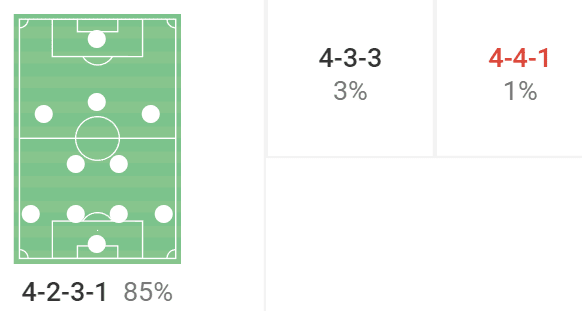
Feyenoord’s starting elevens have been largely consistent over the past few months and there is a heavy emphasis from the new manager on having players in the team that are comfortable in possession.
Having these players profiles on the side allows Slot to play a certain way. The personnel also possess high tactical intelligence and are capable of playing in numerous positions to bring Slot’s ideology of positional fluidity to fruition.
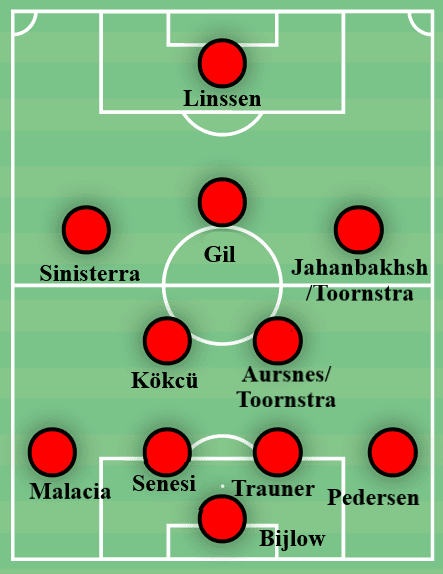
This is Feyenoord’s most used starting eleven this season in their 4-2-3-1 shape. The players allow Slot to play a certain brand of football.
There is a general misconception within the beautiful game from an outside perspective that managers mould players to play a certain brand of football even when the squad doesn’t possess the necessary personnel.
This just is not the case. Pep Guardiola was forced to overhaul Manchester City’s starting eleven before he could properly implement his philosophy on the team, likewise with Jurgen Klopp at Liverpool.
Bringing this point back to how it affects Feyenoord, without the players being comfortable playing in certain areas of the pitch, Slot’s team would not be capable of executing such a fluid brand of football.
The fullbacks represent this better than any other players. Both Marcus Pedersen and Malacia are congenial to drifting inside and playing as ‘inverted’ fullbacks but can also hold the width. These individual qualities within the tactical system will be analysed in greater detail.
Different Build-Up Methods
As Feyenoord play a 4-2-3-1 for the most part, their build-up structure generally remains the same as this with the double-pivot staying behind the opposition’s first line of pressure.
The fullbacks push high while the two centre-backs split and allow the goalkeeper to practically become a third ball-player in a temporary back three.
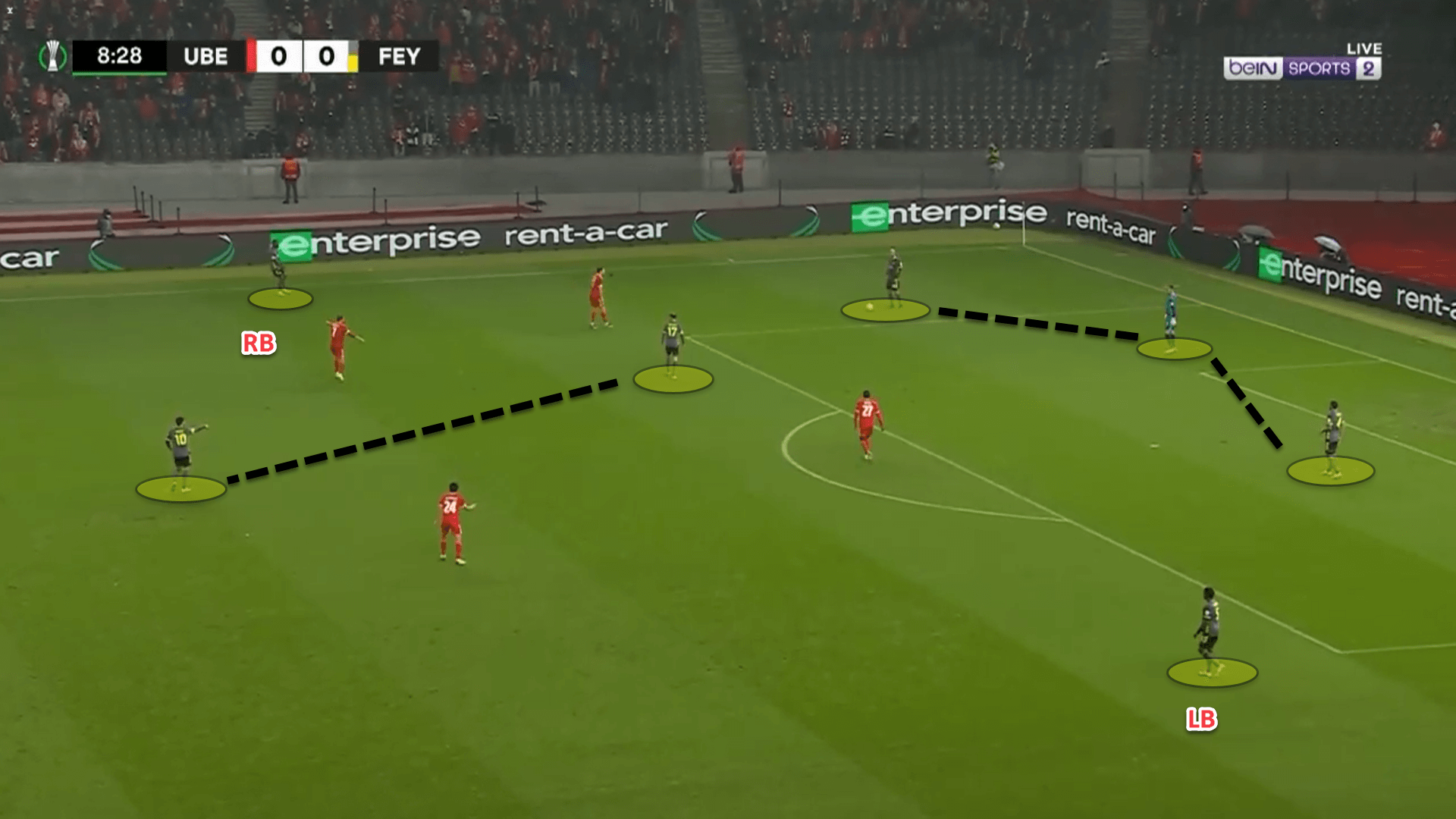
The double-pivot always stagger too which is an important characteristic for any midfield in a possession-based system. Staggering essentially means that players will occupy different vertical and horizontal lines on the pitch. This stretches the opponent both vertically and horizontally.
Playing on the same horizontal and vertical line is far too easy for teams to defend against because it doesn’t allow for proper pitch coverage. For Slot, his objective is to have his players covering as many areas of the pitch as possible, not the same area.
The double-pivot are tasked with ensuring that they do not remain stagnant while the ball is in front of them with the backline or goalkeeper. Slot wants his two holding midfielders to constantly drift into space behind the first line of pressure, rotating, interchanging and looking to receive the ball to progress the team forward.
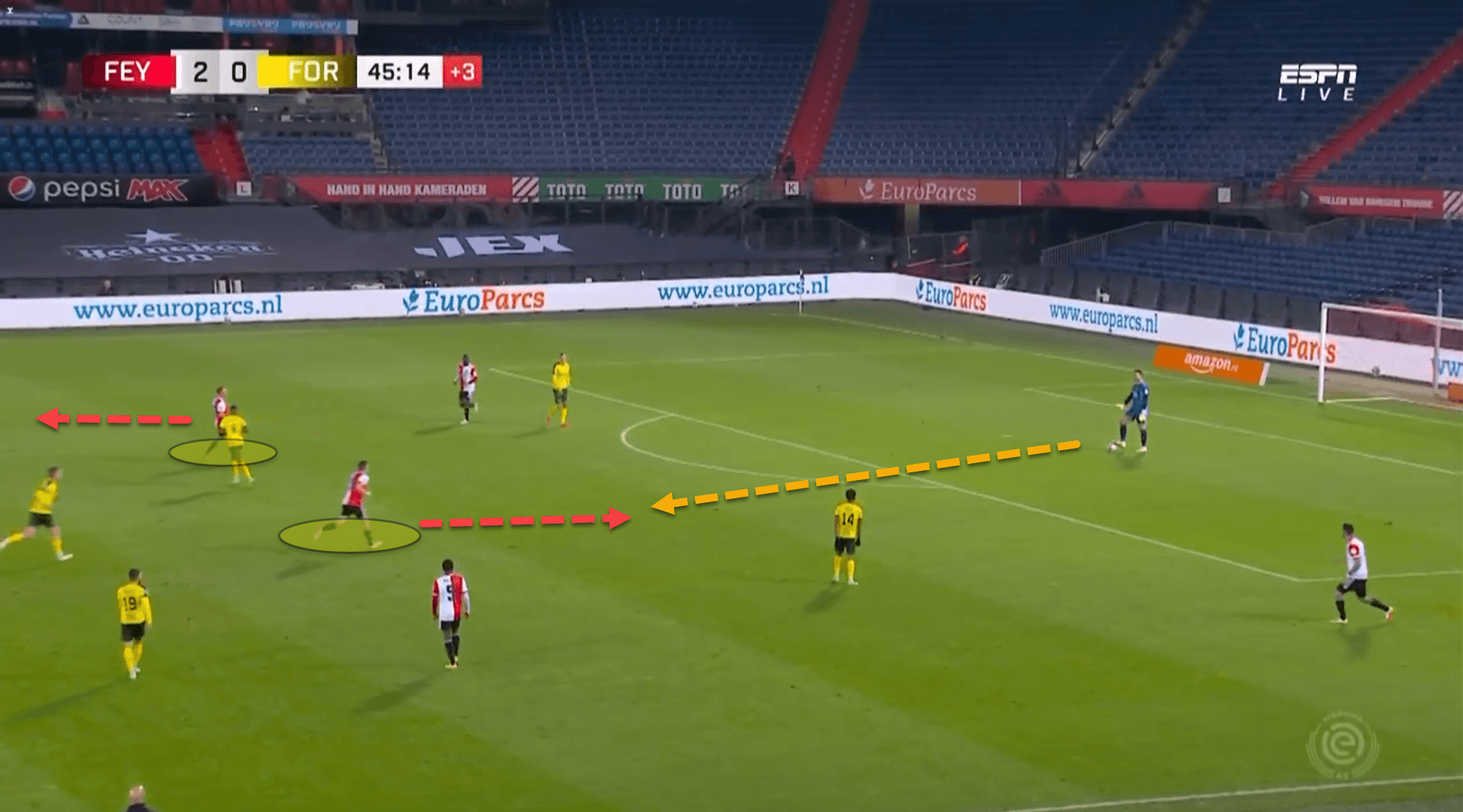
Here, one defensive midfielder has dropped short while his partner is back-pedalling to move further up the pitch, maintaining their spatial coverage while also creating passing angles.
The fullbacks tend to position themselves deeper when Feyenoord are facing a team that presses high but against a side that drops off into a defensive mid-block instead of pressing, it gives license to the fullbacks to advance forward. The goalkeeper and central defenders also come out to the edge of the area.
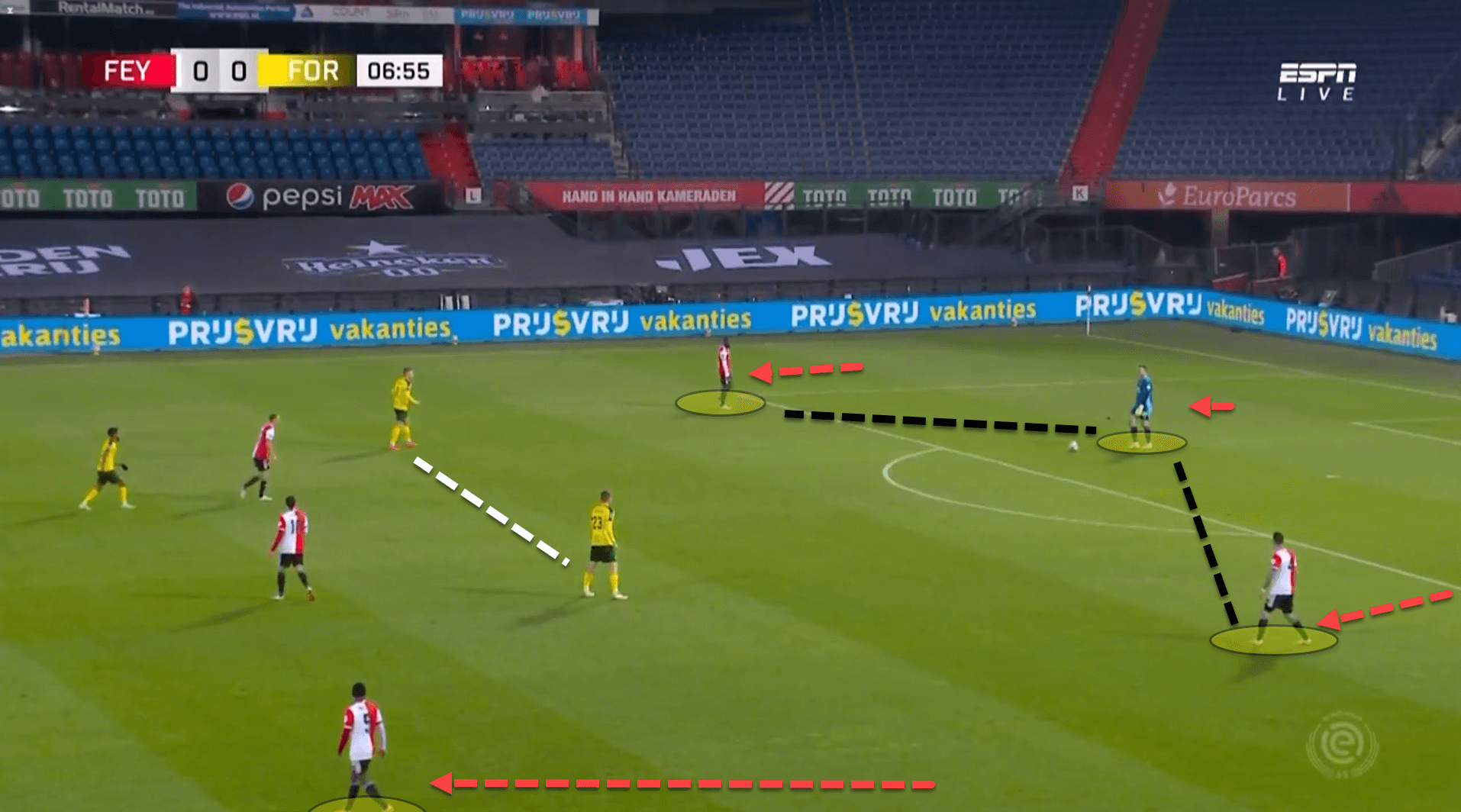
This is a risky strategy for the obvious reason that the goalkeeper is at the edge of the box. Many reactive coaches would not risk doing so which is completely understandable from a tactical perspective.
However, Slot trusts his goalkeepers. Bijlow, and even the second-choice keeper, Ofir Marciano, are comfortable with the ball at their feet which minimises the risk of a poor pass occurring.
Pushing the keeper to the edge of the area with the centre-backs splitting wide can be extremely useful when executed perfectly. As can be seen from the previous image, it allows Feyenoord to create a 3v2 situation against the opposition’s first line of pressure without having to tuck a fullback inside or drop a midfielder into the backline.
Feyenoord’s build-up play is really vertical, crisp and rapid. Unlike some Dutch coaches, Slot doesn’t want slow build-up. The ball needs to be moved fast with risky passes, breaking the opponent’s lines for faster and smoother ball progression up the pitch.
Feyenoord have completed the second-highest number of progressive passes per 90 in the Eredivisie this season with 79.81. As expected, only Ajax have achieved more. Their accuracy on these passes has been an impressive 81.2 percent. Again, only Ajax has a better rate.
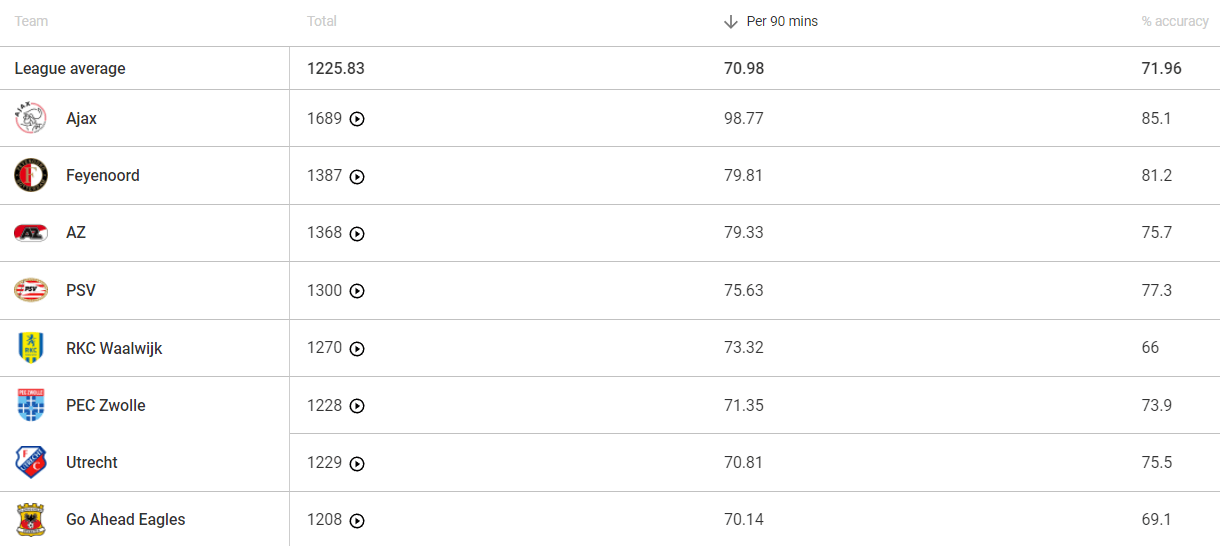
Some of these passes are long balls. While sticking to strict positional play principles, Feyenoord are also very capable of switching up their play and simply going long towards a front-man.
In order to do this, there needs to be a realistic target for the direct ball and a support system to regain the second ball. Guus Til is generally the target due to his height and physical stature.
When creating a good support structure for the long ball, Slot instructs at least two players to support from in front of the ball and, if possible, one in behind.
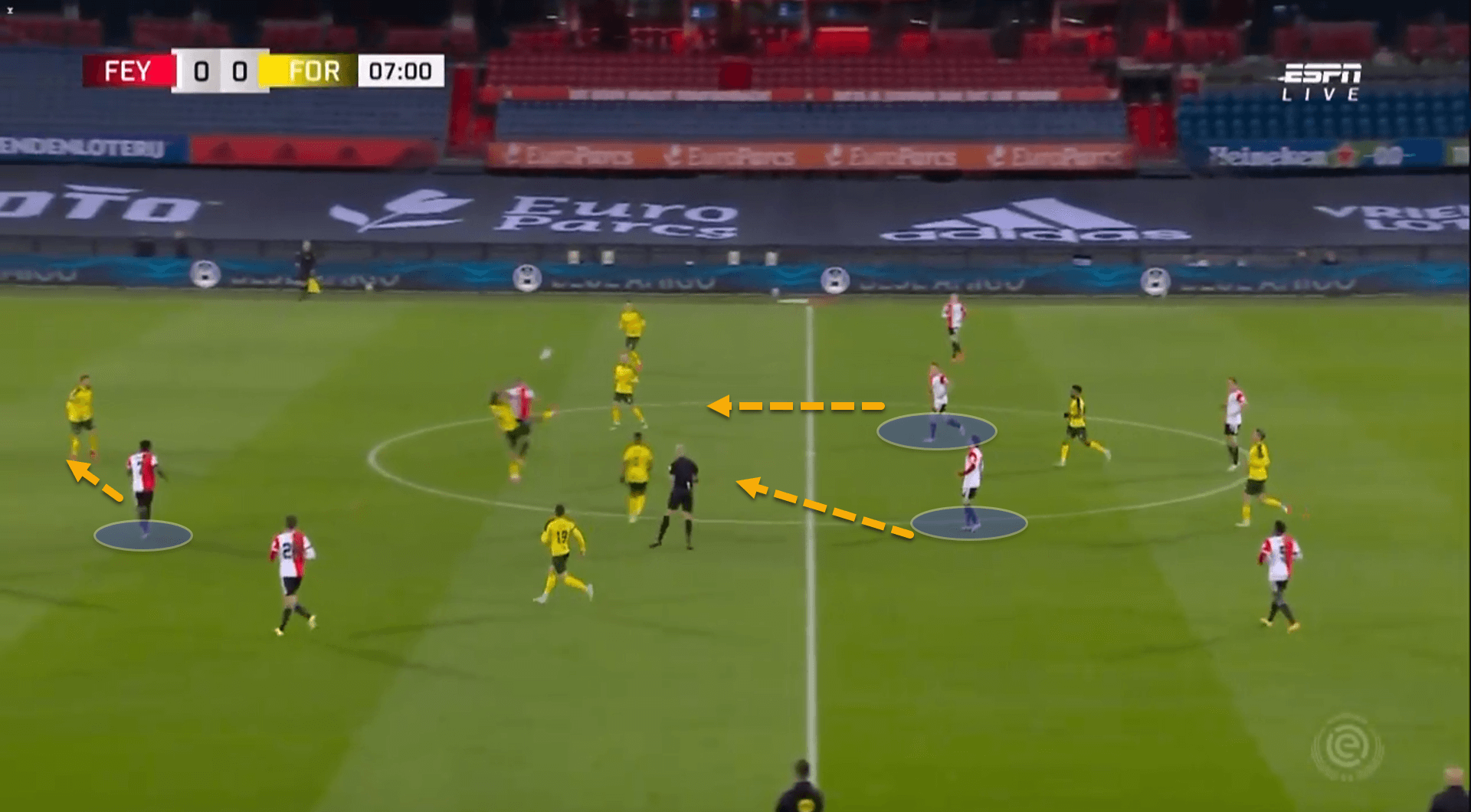
One attacking the flick-on and two trying to collect the second balls in front of the player. Feyenoord have averaged 49 long balls per game this season so far in all official competitions.
Wide Overloads And Positional Rotations
One way in which Slot has insisted that his players reach the final third is through creating wide overloads on one side of the pitch in order to free up a winger or a fullback on the far side in a 1v1 situation.
Manchester City’s assistant manager, Juanma Lillo, a highly-influential figure in the modern game was once quoted saying, “The principle idea of positional play is that players pass the ball to each other in close spaces to be able to pass to a wide-open man.”
Slot certainly adheres to the principles of positional play and has instilled it in his players already. By overloading one flank, the opposition is forced to push their defensive block across to defend against the numerical exploitation. This leaves vast quantities of space on the far side.
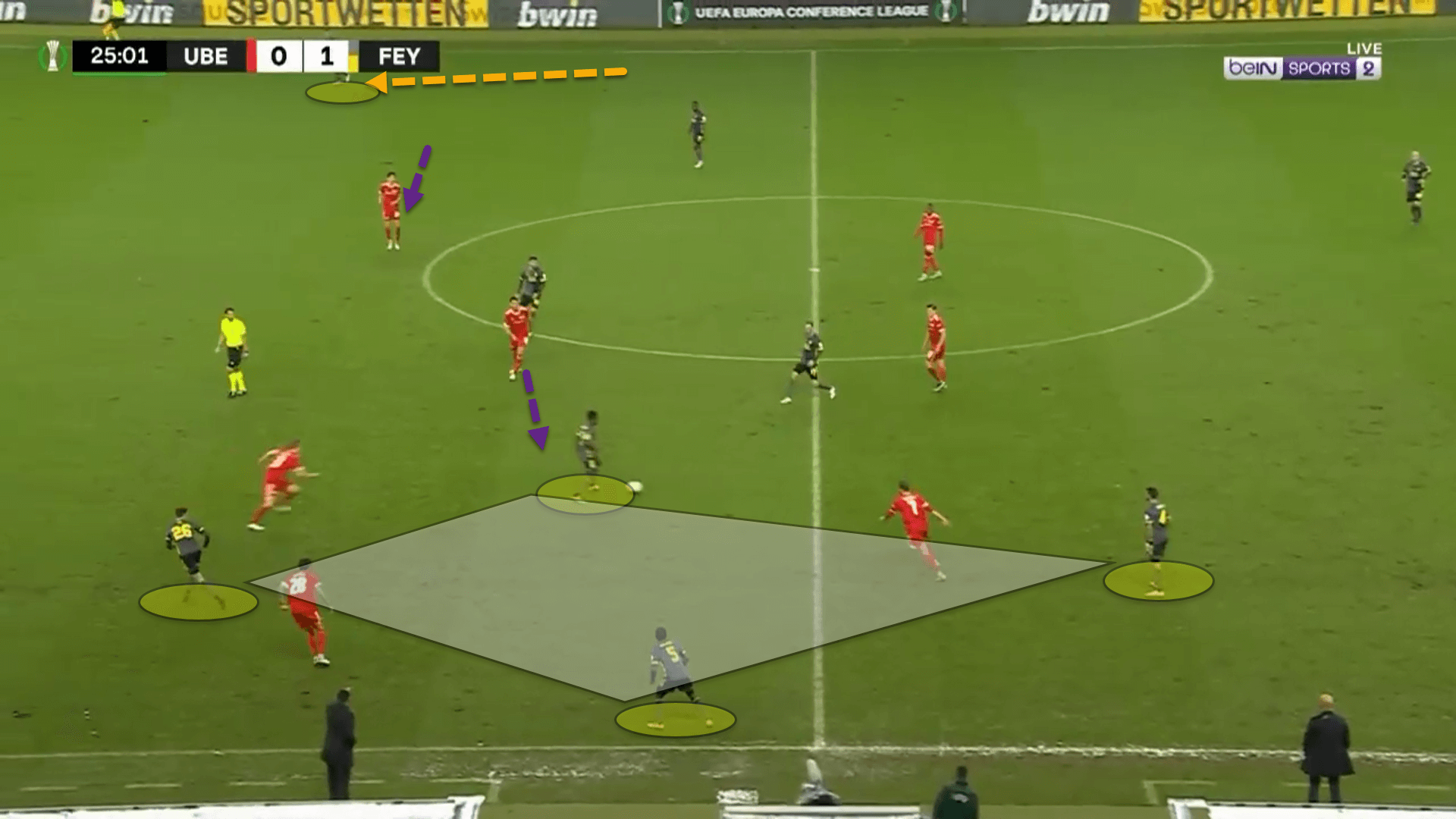
For instance, here, Feyenoord have managed to create a 4v3 situation on the left flank. As a result, Union Berlin are forced to drop their defensive block to one side to ensure that they are no longer numerically inferior.
This is because, if Feyenoord were allowed to constantly get themselves into 4v3 situations in the wide areas, they would be able to break through the defensive team’s structure easily through combination play by using the free-man as well as their quality on the ball.
However, when the opponent drops its defensive block to one side to defend against the overload, it frees up space on the opposite flank for a switch of play.
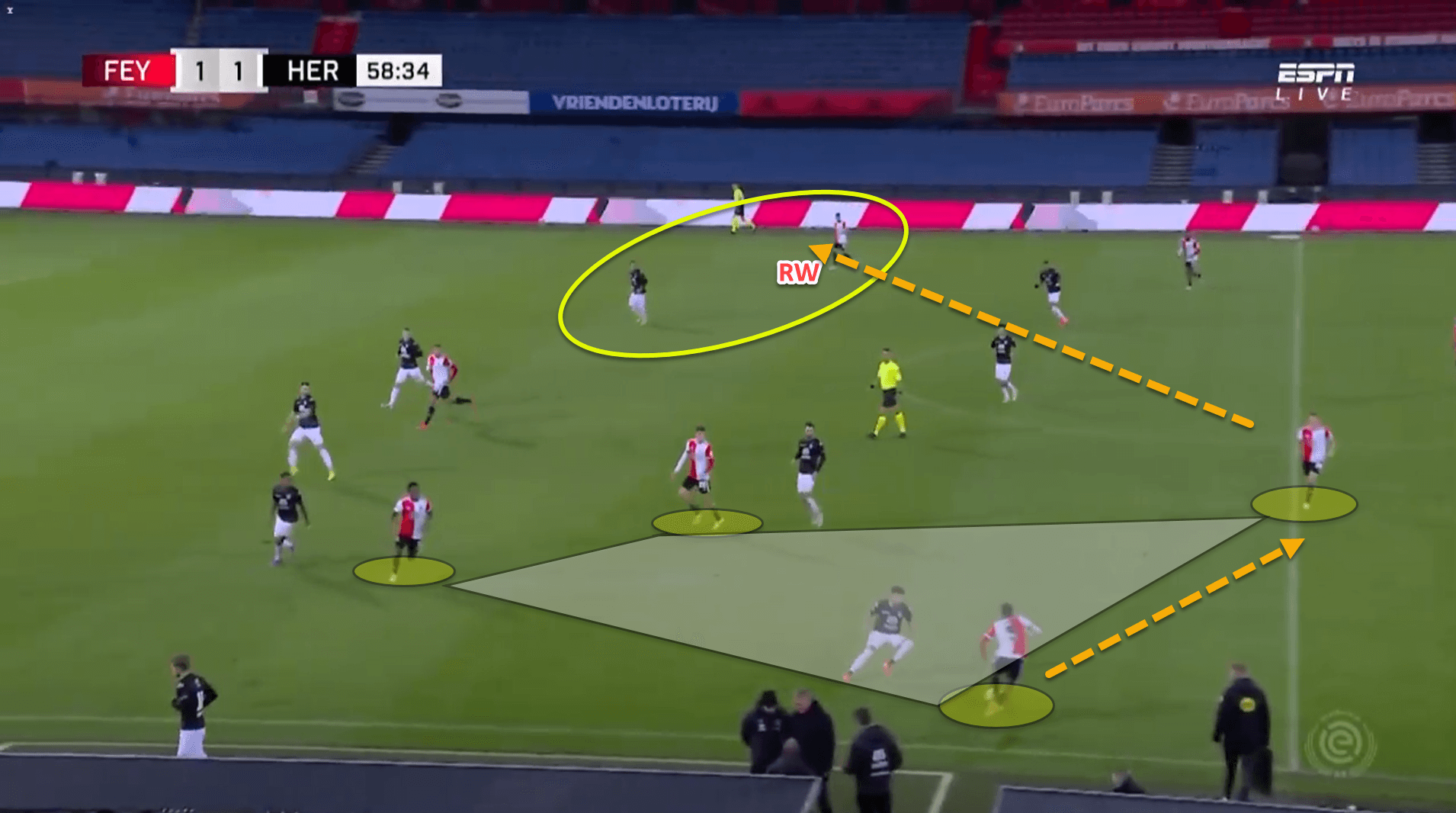
Again here, Feyenoord have created a wide overload on the left-wing. This has created a 1v1 situation for the winger on the far side against the defensive fullback. The trick here is to ensure that the winger has qualitative superiority against his man which will give Feyenoord the best chance at bearing down on goal.
Providing the players can move the ball and quickly switch it to the far side, Feyenoord have a wonderful chance of breaking through the opposition’s defensive block.
Slot also wants to adhere to the Gods of positional play by having players create positional superiority between the lines. This prong of the ‘three superiorities’ is vital for possession-based teams and essentially occurs when a player receives the ball between the lines with both time and space to turn on the ball and play out.
Feyenoord play a game of chess during the possession phases. Players will move into unconventional areas of the pitch to occupy spaces in order to free up some in space between the lines.
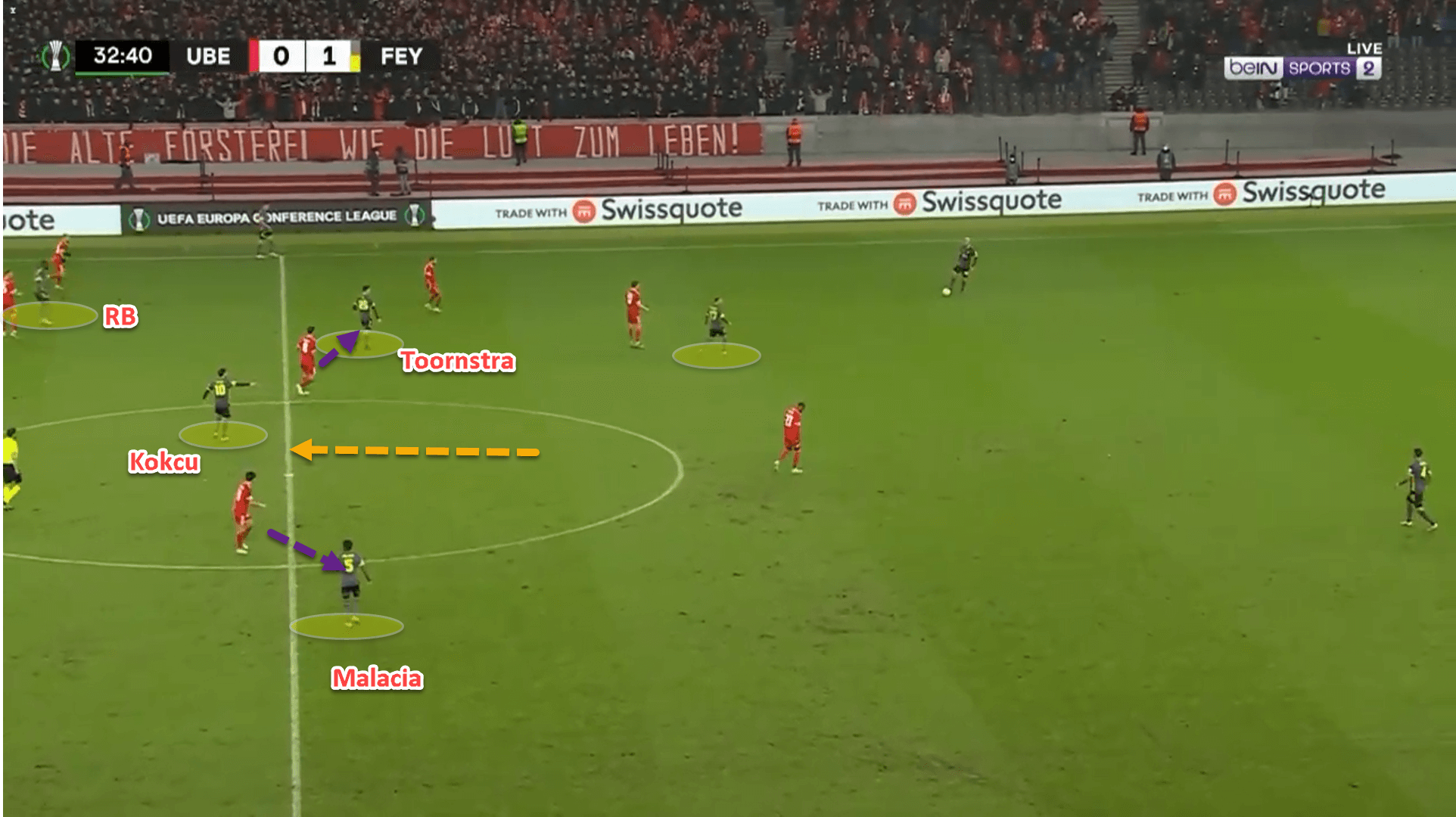
For example, here, Kökçü has pushed up into the space between the lines. To get him into the best position possible to receive and turn facing the goal, Toornstra, the right-winger has dropped and pinned two of the three central midfielders from Union Berlin.
Malacia has inverted to occupy the last remaining midfielder while the right-back, Lutsharel Geertruida, the left-winger and the striker are also pinning the backline back to stop any from stepping out to close Kökçü down if he receives the ball.
This is extremely intelligent positional play. Pep Guardiola would certainly be proud of Slot who he undoubtedly influenced.
Counterpressing
Finally, as with all great teams who dominate possession such as Liverpool, Manchester City and Chelsea, defending against transitions is vital. This is because teams who like to hold the ball play very high defensive lines.
When a team is in a structured positional attack, the players be thinking of defensive transitions in the back of their minds. This is another useful feature of wide overloads. If a player loses the ball, there are already multiple players in one area to counterpress and regain possession high up the pitch.
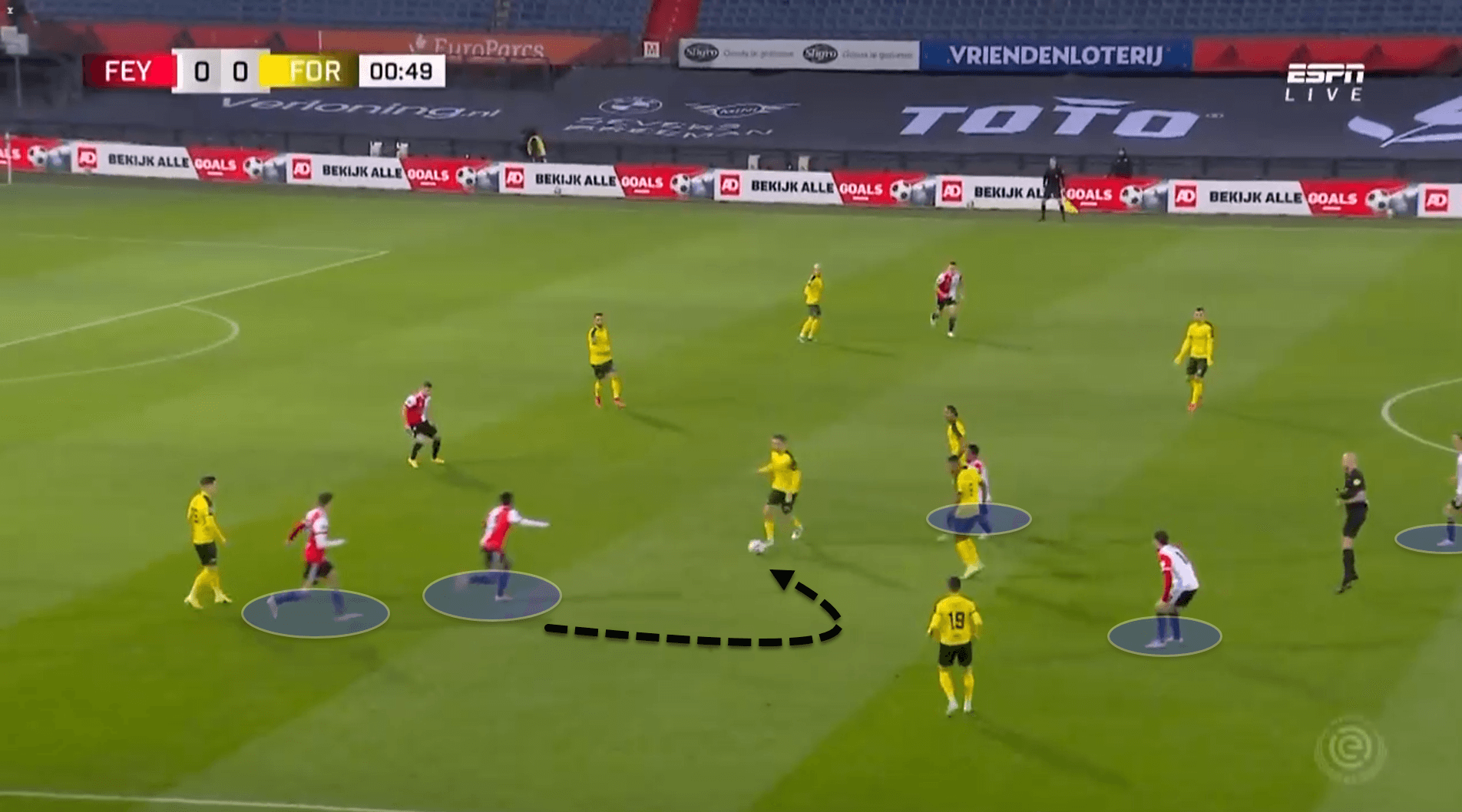
Here, Feyenoord have just lost the ball through an overload on the left flank. There are already 4-5 players in close proximity to the ball carrier that can apply pressure and cut off passing lanes in order to regain possession of the ball as quickly as possible.
It is of absolute importance that players, who drop short towards the ball-carrier while in possession, position themselves close to an opposition player but not too close as to have their pass intercepted.
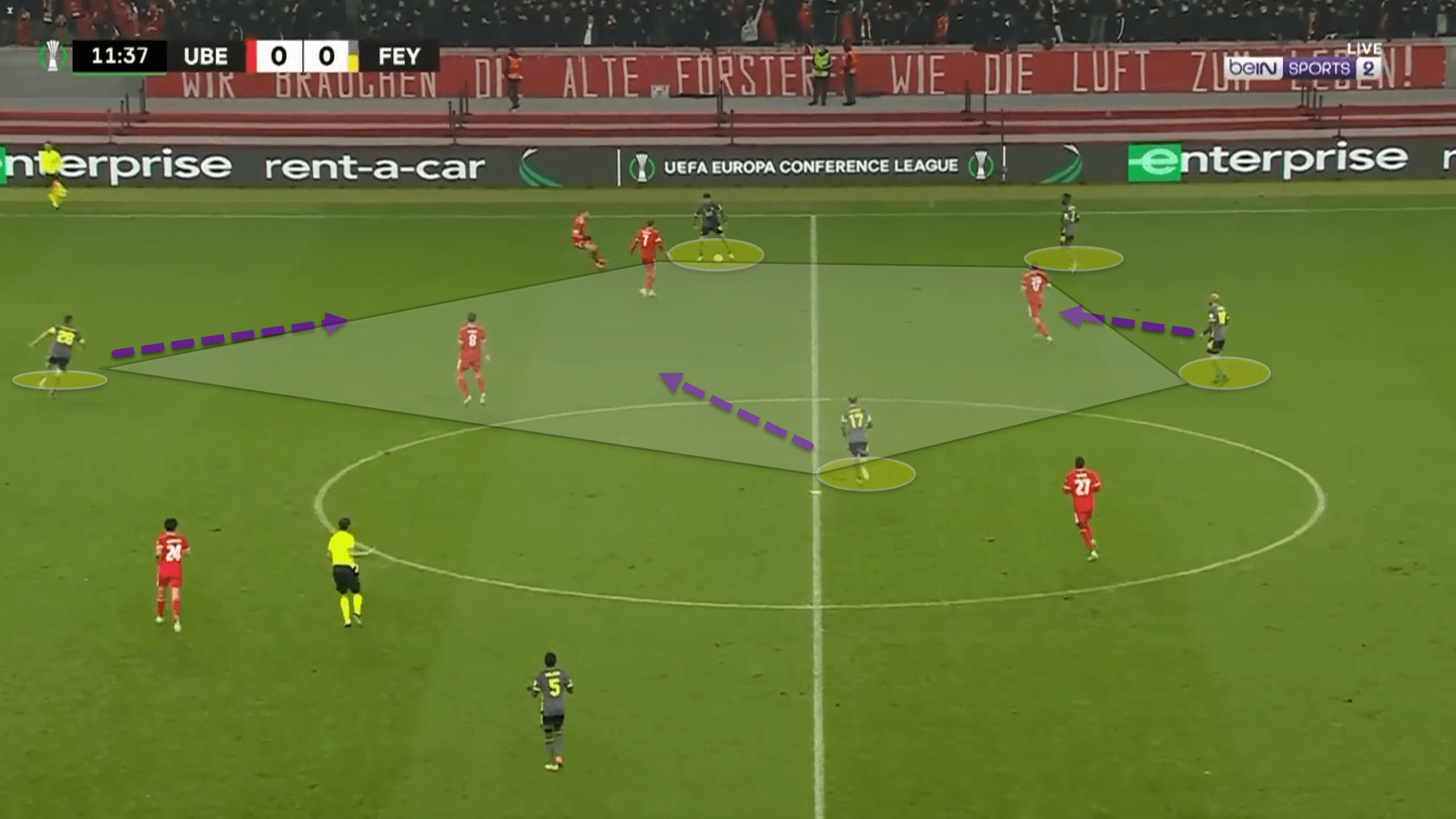
For instance, in this image, Feyenoord have created an overload on the right flank this time. The player have all positioned themselves close to an opposition player so as to be nearest to them to counterpress if the ball is overturned.
However, the players are not close enough that they do not have space to receive, just less space than usual.
Having players who are comfortable under pressure when receiving and passing is vital to being successful in a positional play system as they can play in tight spaces, have a successful rest defence structure, and also have a complete positional attacking structure as well.
Conclusion
Slot has done a wonderful job with this side. His predecessor, the legendary Dick Advocaat, was underwhelming at best and the team finished fifth in the 2020/21 campaign.
Now, they look like proper title contenders in the Eredivisie.
The team look completely brand new and are playing a beautiful brand of football in pure cohesion, almost as if the players have been together all their lives in the same side.
Even Arne Slot himself will be surprised by how quickly the players have adapted to his philosophy of the game.






Comments